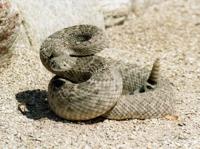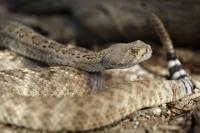10 tips for surviving rattlesnake season in Tucson
With warmer days upon us, rattlesnakes are coming out of hibernation to seek out some sunlight.Â
Arizona, which sees around 200 reported rattlesnake bites a year, is home to 13 species of rattlesnakes, with eight or nine species living in southeastern Arizona.
They range far and wide — from deserts, canyons and forests to urban backyards.
Some rattlers slither a mile or more from their dens to places where they spend the summer, say department biologists.
The venomous vipers sometimes rattle before striking — but not always. So use these 10 tips to survive snake season wherever you go!
Watch your step!

Be on the lookout for rattlesnakes, whether you're out hiking or in your backyard. Rattlesnakes are known to blend in with their environments. When traveling during the night, carry a flashlight to make sure every step is the right one.
"If you encounter a snake, take one or two steps back in an effort to get out of striking range," said Keith Boesen, director of the Arizona Poison and Drug Information Center.
Don't put your hands where you can't see

Avoid reaching into areas obscured by brush or rocks, there's no telling what lies in waiting in those hidden spaces. You could be reaching blindly into a shrub or brush where a snake may be hanging out.
Don't approach or provoke the snakes

More than half of all rattlesnake bites are caused by provoking or approaching a snake, the Arizona Game and Fish Department said. Children should be taught about dangerous desert animals and how to avoid risky interactions with them.
Rodent control

Rattlesnakes are attracted to their vital resources including food, water, and a safe place to live. Rodents should be eliminated from around your home. Start by filling all the holes that you find.
If possible, you can use snap traps and live traps but using poison traps might kill the wrong animals, officials say.
Other possible deterrents

Walls can be built to discourage rattlesnakes from enclosed areas. Specialists say a solid wall around four feet high will keep out most snakes. The bottom of the wall should be placed into the ground with no tunnels underneath.
You should also cover drainage holes with quarter-inch hardware cloth. A one-inch opening is an open door to a snake.Â
Reminder: These may be deterrents but there is no such thing as a 100 percent snake-proof fence. A snake may climb virtually any wall, and a tiny snake can move through small crevices.
Call your local emergency response department

Some fire departments will remove rattlesnakes confined in a yard or residence. Check with the department covering your area for more information about the services they provide.
Tips for if you're bitten: Go immediately to a hospital

Respond quickly by going to a medical facility and get treatment, if needed. If you're with someone who is bitten, remain calm and reassure them.
Remove items such as jewelry and watches from the affected area. Make sure to keep the affected area at a level below the heart. Decrease total body activity as much as you can.
What bite victims should avoid

Don't believe the myths! Refrain from cutting into the bite area or trying to suck out venom. Even tourniquets should be avoided, specialists say. Do not apply ice to the bite area or administer your own alcohol or drugs in an attempt at first aid.
Don’t forget about your pets

Pets are sometimes bitten by rattlesnakes. "Cats, by behavior, tend to hide out after an injury. Despite this, many survive," said Keith Boesen, director of Arizona Poison and Drug Information Center.
"Although many large dogs do well with no veterinary care, it is recommended that any pet be taken to an emergency veterinary clinic if bitten," he said.
Some local kennels offer “snake avoidance” training for dogs, which may help.Â
A reminder about some species of rattlesnake

Several species of rattlesnake are protected under state laws in the southwestern United States due to their limited numbers. It is illegal to collect or harm these protected rattlesnakes like the ridge-nosed rattlesnake, the state reptile.















